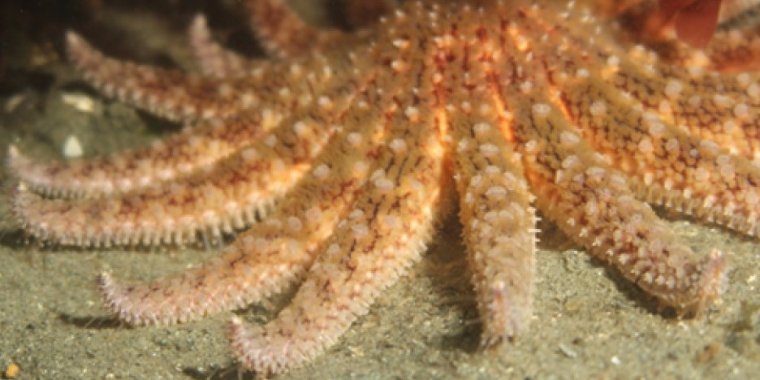| News / Science News |
Sea stars able to consume kelp-eating urchins fast enough to protect kelp forests
A research team including scientists at Oregon State University has provided the first evidence that a species of endangered sea star protects kelp forests along North America's Pacific coast by preying on substantial numbers of kelp-eating urchins.

New research shows that sunflower sea stars consume kelp-eating urchins fast enough to protect kelp forests. Photo: Janna Nichols
The study is important because giant kelp, with its ecological and economic importance around the world, is under siege from environmental change and overgrazing by sea urchins.
The findings suggest that the sunflower sea star, Pycnopodia helianthoides, likely plays a much stronger role in kelp forest health than had been thought. Experiments showed that sunflower sea stars consume urchins at rates sufficient to maintain and perhaps reset the health of kelp forests.
"These results demonstrate that sunflower sea stars regulate purple sea urchin populations and thereby maintain healthy kelp forests," said Daniel Thornhill, a program director in NSF's Division of Ocean Sciences.
"What we saw suggests a clear link between the crash of sea stars, the explosion in sea urchin populations and the decline in kelp," said paper co-author Sarah Gravem of Oregon State. "It also points to sea star recovery as a potential key tool for kelp forest recovery."
Giant kelp occupies nearly 50% of the world's marine ecoregions. It thrives in cold water, where it forms large undersea forests that provide essential habitat, food and refuge for many species, including sea urchins and sea stars.
Sunflower sea star populations, however, suffered dramatic downturns due to a marine wildlife epidemic, sea star wasting syndrome, that began in 2013.
Scientists used more than 61,000 population surveys from 31 datasets to calculate a 90.6% decline in sunflower sea stars, and estimated that as many as 5.75 billion animals died from the disease. The cause has not been determined.
To date, there are no indications of sunflower sea star population recovery in any region in the years since the outbreak. No sunflower stars have been seen in Mexico since 2016, and only a handful have been found in Oregon and California since 2018.
Researchers thought the sea star decline helped fuel an explosion in the urchin population in many regions, with an overabundance of urchins placing added pressure on kelp forests already challenged by marine heat waves.
But before the new study, the relationship among sea stars, urchins and kelp had not been quantified, Gravem said.
"This study addresses that gap, and the findings are significant and somewhat surprising," said lead scientist Aaron Galloway of the University of Oregon, also a paper co-author. "We found that these sea stars are eager consumers of purple sea urchins."
The research shows that sunflower sea stars on average eat about 0.68 sea urchins per day, and that they eat starved urchins associated with barrens 21% faster than they consume the well-fed urchins typical of healthy kelp forests.
"We used a model to show that the pre-disease densities of sea stars on the U.S. West Coast were usually more than enough to keep sea urchin numbers down and prevent barrens," Gravem said. (U.S. National Science Foundation)
YOU MAY ALSO LIKE





